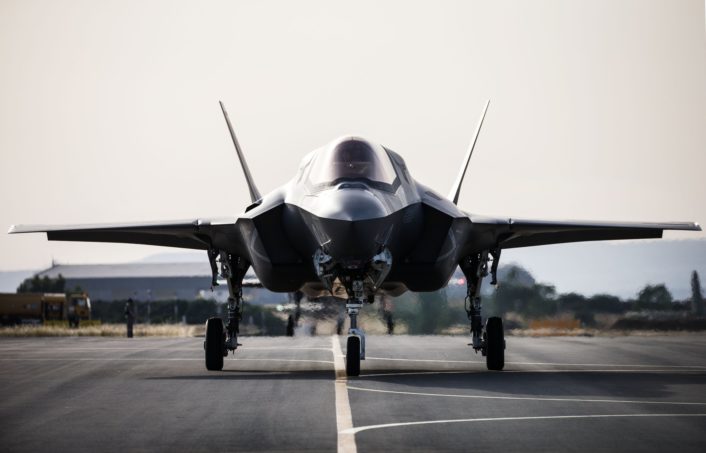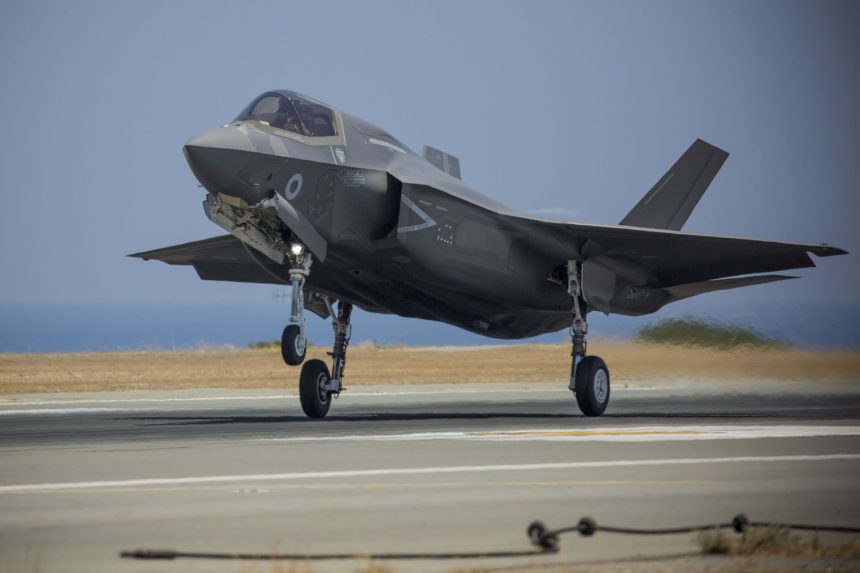The RAF Lightning deployed to RAF Akrotiri have carried out the first combat sorties last week.
The Royal Air Force has become the fourth air arm (after the Israeli Air Force, the U.S. Marine Corps and the U.S. Air Force) to carry out combat missions with the F-35 Lightning II Joint Strike Fighter.
The UK Defence Secretary has in fact unveiled that the six of nice British F-35B Lightning (worth of note, the British designation is “Lightning” and not “Lightning II”) aircraft deployed since May 21 to RAF Akrotiri for Exercise “Lightning Dawn”, have carried out their first sorties over Syria and Iraq, taking part in the ongoing fight against Daesh.
“Due to the exceptional performance of the aircraft, pilots, and support staff during [the training period at Cyprus for Lightning Dawn], it was decided that they were ready to make their operational debut from RAF Akrotiri, alongside the Typhoons,” says the official statement.

“The F-35s are the most advanced jets our country has ever possessed and will form the backbone of British air defence for decades to come. They have passed every test their training has thrown at them with flying colours and their first real operational mission is a significant step into the future for the UK,” Defence Secretary Penny Mordaunt said visiting Akrotiri.
The first RAF F-35B operational sorties were flown on Sunday Jun. 16 in support of Operation Shader, the UK contribution to the Global Coalition’s counter Daesh mission in Iraq and Syria. The two aircraft conducted a patrol over Syria, and UK F-35s have flown a further 12 sorties since then.
Interestingly, photos of the aircraft released by the UK MOD show Paveway IV bombs being loaded and the AIM-120 AMRAAM carried inside the internal weapons bay. Moreover, the aircraft feature their RCS (Radar Cross Section) enhancers (also known as radar reflectors/Luneberg lenses).
A few more MoD images from #Akrotiri of the F-35s being geared up for missions over #Iraq and #Syria. HT to @TheBrit96 for spotting that the jets were kitted out with AMRAAM even though the F-35s were operating alongside Typhoons. Short story: https://t.co/QUItGjRblU pic.twitter.com/MnIz481GK5
— Tony Osborne (@Rotorfocus) June 25, 2019
As I explained here at The Aviationist last year, radar reflectors are used to exaggerate the aircraft’s real RCS and negate the enemy the ability to collect any detail about their LO “signature”. In Syria and Iraq the risk is probably to “feed” the Russian S-400 air defense system, hence the use of devices used to become more visible to radars. Actually, the use of Luneberg lenses is also an option in case of war, when enemy air defense assets including sensors, air defense missile and gun systems and enemy aircraft are degraded by airstrikes and the environment becomes more permissive: in such a scenario the F-35 no longer relies on low-observable capabilities for survivability so it can shift to carrying large external loads, and go in a so-called “beast mode”.
USAF F-35s flying over Iraq and Syria during their first deployment in the CENTCOM AOR (Area of Responsibility) carry their radar reflectors (as well as external AIM-9X Sidewinder Air-to-Air Missiles): in other words, all the Lightnings in the region are not flying in “stealth mode”.
BTW, USAF F-35A, Israeli F-35I Adir and RAF F-35B Lightning have taken part in Exercise Tri-Lightning over eastern Mediterranean, on June 25:
#Airpower, it’s what we do! Thank you Royal #AirForce and @IAFsite for a great exercise! Read about #TriLightning for yourself! https://t.co/YFUJ53XsWA@usairforce @CENTCOM @DeptofDefense #USAF #Military #F35 #Aviation #Aircraft pic.twitter.com/tyFeRrjFAe
— US AFCENT (@USAFCENT) June 25, 2019
The UK currently operates 17 F-35Bs, nine of which are assigned to 617 Sqn at RAF Marham, UK (six, as said, are currently deployed to the eastern Med Sea), with the Operational Conversion Unit (No 207 Squadron) expected to start operations from Marham from the end of July as more jets arrive in the UK from MCAS Beaufort, where they have been used for joint training alongside the US Marine Corps.
Later in the year, 617 Squadron will embark aboard HMS Queen Elizabeth for the first time. “The UK jets will conduct Operational Tests, alongside 17 Test and Evaluation Squadron, onboard the carrier in the USA during the WESTLANT 19 deployment, proving their capability at sea. This is vital step on the path to the first Carrier Strike Deployment planned for 2021,” says the UK MOD.









